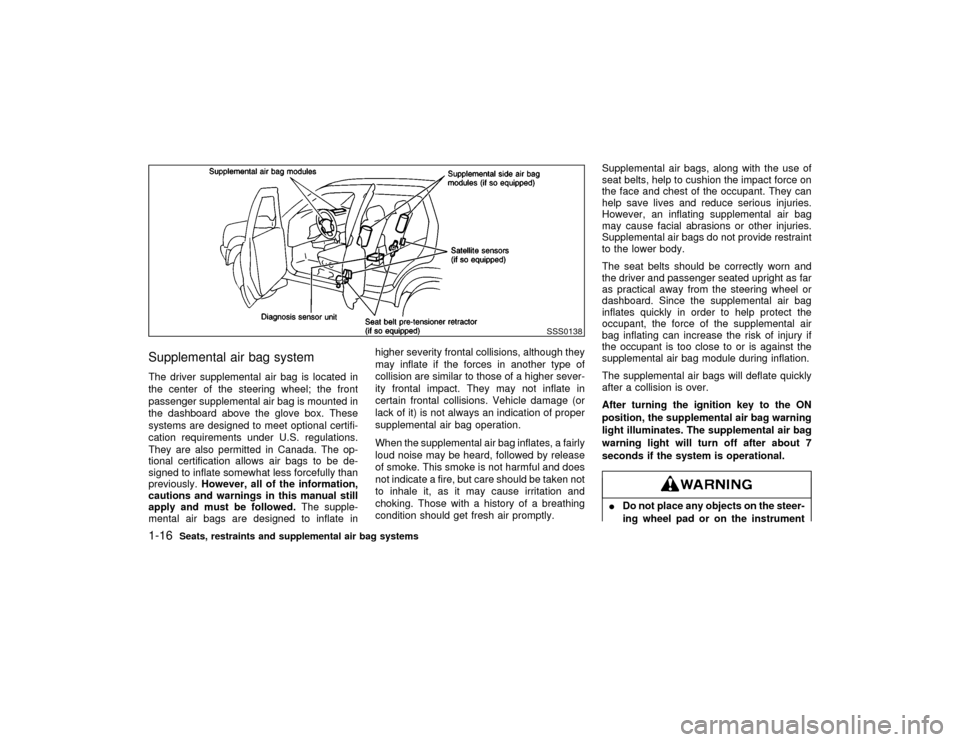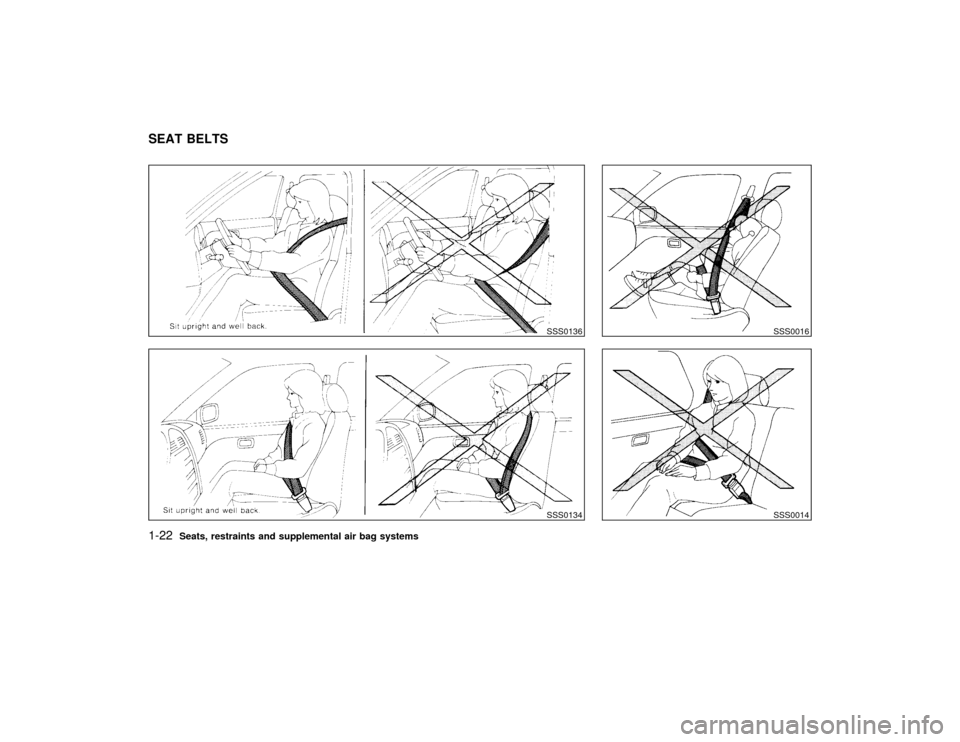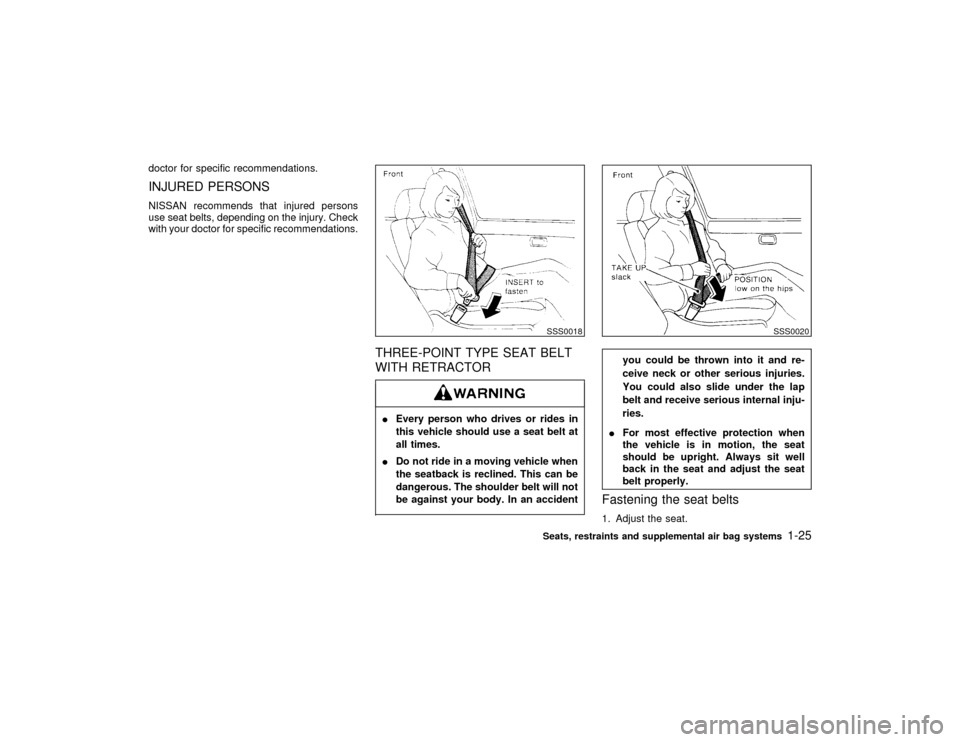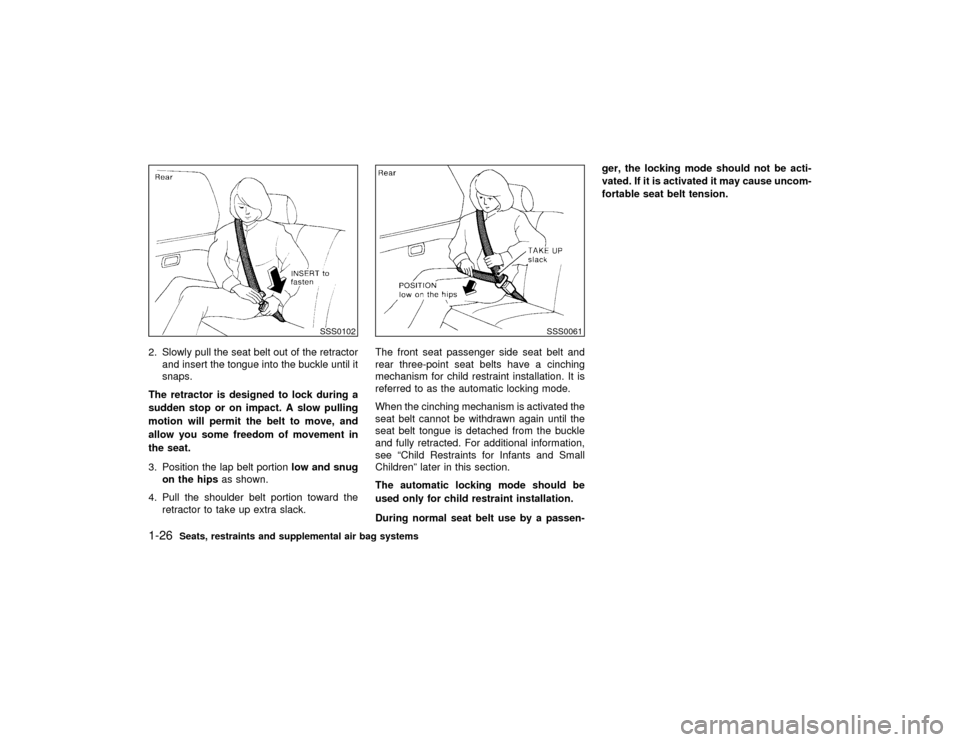belt NISSAN PATHFINDER 1999 R50 / 2.G User Guide
[x] Cancel search | Manufacturer: NISSAN, Model Year: 1999, Model line: PATHFINDER, Model: NISSAN PATHFINDER 1999 R50 / 2.GPages: 274, PDF Size: 2.34 MB
Page 23 of 274

Supplemental air bag systemThe driver supplemental air bag is located in
the center of the steering wheel; the front
passenger supplemental air bag is mounted in
the dashboard above the glove box. These
systems are designed to meet optional certifi-
cation requirements under U.S. regulations.
They are also permitted in Canada. The op-
tional certification allows air bags to be de-
signed to inflate somewhat less forcefully than
previously.However, all of the information,
cautions and warnings in this manual still
apply and must be followed.The supple-
mental air bags are designed to inflate inhigher severity frontal collisions, although they
may inflate if the forces in another type of
collision are similar to those of a higher sever-
ity frontal impact. They may not inflate in
certain frontal collisions. Vehicle damage (or
lack of it) is not always an indication of proper
supplemental air bag operation.
When the supplemental air bag inflates, a fairly
loud noise may be heard, followed by release
of smoke. This smoke is not harmful and does
not indicate a fire, but care should be taken not
to inhale it, as it may cause irritation and
choking. Those with a history of a breathing
condition should get fresh air promptly.Supplemental air bags, along with the use of
seat belts, help to cushion the impact force on
the face and chest of the occupant. They can
help save lives and reduce serious injuries.
However, an inflating supplemental air bag
may cause facial abrasions or other injuries.
Supplemental air bags do not provide restraint
to the lower body.
The seat belts should be correctly worn and
the driver and passenger seated upright as far
as practical away from the steering wheel or
dashboard. Since the supplemental air bag
inflates quickly in order to help protect the
occupant, the force of the supplemental air
bag inflating can increase the risk of injury if
the occupant is too close to or is against the
supplemental air bag module during inflation.
The supplemental air bags will deflate quickly
after a collision is over.
After turning the ignition key to the ON
position, the supplemental air bag warning
light illuminates. The supplemental air bag
warning light will turn off after about 7
seconds if the system is operational.
IDo not place any objects on the steer-
ing wheel pad or on the instrument
SSS0138
1-16
Seats, restraints and supplemental air bag systems
Z
01.1.22/R50-D/V5
X
Page 24 of 274

panel. Also, do not place any objects
between any occupant and the steer-
ing wheel or instrument panel. Such
objects may become dangerous pro-
jectiles and cause injury if the supple-
mental air bags inflate.
IRight after inflation, several supple-
mental air bag system components
will be hot. Do not touch them; you
may severely burn yourself.
INo unauthorized changes should be
made to any components or wiring of
the supplemental air bag system.
This is to prevent accidental inflation
of the supplemental air bags or dam-
age to the supplemental air bag sys-
tem.
IDo not make unauthorized changes
to your vehicle's electrical system,
suspension system or front end
structure. This could affect proper
operation of the supplemental air bag
system.
ITampering with the supplemental air
bag system may result in serious
personal injury. Tampering includes
changes to the steering wheel andthe instrument panel assembly by
placing material over the steering
wheel pad and above the dashboard,
or by installing additional trim mate-
rial around the supplemental air bag
system.
IWork around and on the supplemen-
tal air bag system should be done by
an authorized NISSAN dealer. Instal-
lation of electrical equipment should
also be done by an authorized
NISSAN dealer. The SRS wiring har-
nesses* should not be modified or
disconnected. Unauthorized electri-
cal test equipment and probing de-
vices should not be used on the
supplemental air bag system.
* The SRS wiring harnesses are cov-
ered with yellow insulation either just
before the harness connectors or
over the complete harness for easy
identification.
When selling your vehicle, we request that you
inform the buyer about the supplemental air
bag system and guide the buyer to the appro-
priate sections in this Owner's Manual.
Supplemental side air bag system (if
so equipped)The supplemental side air bags are located in
the outside of the seatback of the front seats.
The supplemental side air bag (on the driver or
front passenger seat) is designed to inflate in
higher severity side collisions, although it may
inflate if the forces in another type of collision
are similar to those of a higher severity side
impact. It is designed to inflate on the side
where the vehicle is impacted. It may not
inflate in certain side collisions. Vehicle dam-
age (or lack of it) is not always an indication of
proper supplemental side air bag operation.
When the supplemental side air bags inflate, a
fairly loud noise may be heard, followed by
release of smoke. This smoke is not harmful
and does not indicate a fire, but care should be
taken not to inhale it, as it may cause irritation
and choking. Those with a history of a breath-
ing condition should get fresh air promptly.
Supplemental side air bags along with the use
of seat belts, help to cushion the impact force
on the head and chest of the front occupants.
They can help save lives and reduce serious
injuries. However, an inflating supplemental
side air bag may cause abrasions or other
injuries.
The seat belts should be correctly worn and
Seats, restraints and supplemental air bag systems
1-17
Z
01.1.22/R50-D/V5
X
Page 25 of 274

the driver and passenger seated upright as far
as practical away from the supplemental side
air bags. Since the supplemental side air bags
inflate quickly in order to help protect the front
occupants, the force of the supplemental side
air bag inflating can increase the risk of injury
if the occupant is too close to or is against the
supplemental side air bag module during infla-
tion. The supplemental side air bags will de-
flate quickly after the collision is over.
After turning the ignition key to the ON
position, the supplemental air bag warning
light illuminates. The supplemental air bag
warning light will turn off after about 7
seconds if the system is operational.IDo not place any objects near the
seatback of the front seats. Also, do
not place any objects (an umbrella,
bag, etc.) between the front door fin-
isher and the front seat. Such objects
may become dangerous projectiles
and cause injury if the supplemental
side air bags inflate.
IRight after inflation, several supple-
mental side air bag system compo-nents will be hot. Do not touch them;
you may severely burn yourself.
INo unauthorized changes should be
made to any components or wiring of
the supplemental side air bag sys-
tem. This is to prevent accidental
inflation of the supplemental side air
bags or damage to the supplemental
side air bag system.
IDo not make unauthorized changes
to your vehicle's electrical system,
suspension system or side panel.
This could affect proper operation of
the supplemental side air bag sys-
tem.
ITampering with these supplemental
system may result in serious per-
sonal injury. Tampering includes
changes to the front seats assembly
by placing material near the seatback
of the front seat, or by installing ad-
ditional trim material around the
supplemental side air bag system.
IWork around and on the supplemen-
tal side air bag system should be
done by an authorized NISSANdealer. Installation of electrical equip-
ment should also be done by an au-
thorized NISSAN dealer. The SRS wir-
ing harnesses* should not be
modified or disconnected. Unautho-
rized electrical test equipment and
probing devices should not be used
on the supplemental side air bag sys-
tem.
* The SRS wiring harnesses are cov-
ered with yellow insulation either just
before the harness connectors or
over the complete harness for easy
identification.
When selling your vehicle, we request that you
inform the buyer about the supplemental side
air bag system and guide the buyer to the
appropriate sections in this Owner's Manual.Pre-tensioner seat belt system (if so
equipped for front seats)IThe pre-tensioner seat belts cannot
be reused after activation. They must
1-18
Seats, restraints and supplemental air bag systems
Z
01.1.22/R50-D/V5
X
Page 26 of 274

be replaced together with the retrac-
tor as a unit.
IIf the vehicle becomes involved in a
frontal collision but the pre-tensioner
is not activated, be sure to have the
pre-tensioner system checked and, if
necessary, replaced by your NISSAN
dealer.
INo unauthorized changes should be
made to any components or wiring of
the pre-tensioner seat belt system.
This is to prevent accidental activa-
tion of the pre-tensioner seat belts or
damage to the pre-tensioner seat belt
operation. Tampering with the pre-
tensioner seat belt system may result
in serious personal injury.
IWork around and on the pretensioner
system should be done by an autho-
rized NISSAN dealer. Installation of
electrical equipment should also be
done by an authorized NISSAN
dealer. Unauthorized electrical test
equipment and probing devices
should not be used on the pre-
tensioner seat belt system.IIf you need to dispose of the pre-
tensioner or scrap the vehicle, con-
tact an authorized NISSAN dealer.
Correct pre-tensioner disposal proce-
dures are set forth in the appropriate
NISSAN Service Manual. Incorrect
disposal procedures could cause
personal injury.
The front seat pre-tensioner seat belt system
activates in conjunction with the supplemental
air bags. Working with the seat belt retractor, it
helps tighten the seat belt the instant the
vehicle becomes involved in certain types of
collisions, thereby restraining seat occupants.
The pre-tensioner is encased with the seat
belt's retractor. These seat belts are used the
same as conventional seat belts.
When the pre-tensioner seat belt activates,
smoke is released and a loud noise may be
heard. The smoke is not harmful, but care
should be taken not to inhale it as it may cause
irritation and choking.
If any abnormality occurs in the pre-tensioner
system, the seat belt warning light
will
flash intermittently after the ignition key is
turned to the ON or START position. In this
case, the pre-tensioner seat belt will not func-tion properly. The system should be inspected
by an authorized NISSAN dealer.
When selling your vehicle, we request that you
inform the buyer about the pre-tensioner seat
belt system and guide the buyer to the appro-
priate sections in this Owner's Manual.
Seats, restraints and supplemental air bag systems
1-19
Z
01.1.22/R50-D/V5
X
Page 29 of 274

SSS0136SSS0134
SSS0016SSS0014
SEAT BELTS1-22
Seats, restraints and supplemental air bag systems
Z
01.1.22/R50-D/V5
X
Page 30 of 274

PRECAUTIONS ON SEAT BELT
USAGEYour chances of being injured or killed in an
accident and/or the severity of injury may be
greatly reduced if you are wearing your seat
belt and it is properly adjusted. NISSAN
strongly encourages you and all of your pas-
sengers to buckle up every time you drive,
even if your seating position includes a supple-
mental air bag.
Most states, provinces or territories require
that seat belts be worn at all times when a
vehicle is being driven.IEvery person who drives or rides in
this vehicle should use a seat belt at
all times. Children should be properly
restrained and, if appropriate, in a
child restraint.
IThe belt should be properly adjusted
to a snug fit. Failure to do so may
reduce the effectiveness of the entire
restraint systems and increase the
chance or severity of injury in an
accident. Serious injury or death canoccur if the seat belt is not worn
properly.
IAlways route the shoulder belt over
your shoulder and across your chest.
Never run the belt behind your back,
under your arm or across your neck.
The belt should be away from your
face and neck, but not falling off your
shoulder.
IPosition the lap belt as low and snug
as possible AROUND THE HIPS, NOT
THE WAIST. A lap belt worn too high
could increase the risk of internal
injuries in an accident.
IBe sure the seat belt tongue is se-
curely fastened to the proper buckle.
IDo not wear the belt inside out or
twisted. Doing so may reduce its ef-
fectiveness.
IDo not allow more than one person to
use the same belt.
INever carry more people in the ve-
hicle than there are seat belts.
IIf the seat belt warning light glows
continuously while the ignition isturned ON with all doors closed and
all seat belts fastened, it may indicate
a malfunction in the system. Have the
system checked by your NISSAN
dealer.
IOnce the pre-tensioner seat belt has
activated, it cannot be reused and
must be replaced together with the
retractor. See your NISSAN dealer.
IRemoval and installation of the pre-
tensioner seat belt system compo-
nents should be done by an autho-
rized NISSAN dealer.
IAll seat belt assemblies including re-
tractors and attaching hardware
should be inspected after any colli-
sion by your NISSAN dealer. NISSAN
recommends that all seat belt assem-
blies in use during a collision be
replaced unless the collision was mi-
nor and the belts show no damage
and continue to operate properly.
Seat belt assemblies not in use dur-
ing a collision should also be in-
spected and replaced if either dam-
age or improper operation is noted.
Seats, restraints and supplemental air bag systems
1-23
Z
01.1.22/R50-D/V5
X
Page 31 of 274

CHILD SAFETYChildren need adults to help protect them.
They need to be properly restrained.
The proper restraint depends on the child's
size. Generally, infants (up to about 1 year and
less than 20 lb (9 kg)) should be placed in rear
facing child restraints. Front facing child re-
straints are available for children who outgrow
rear facing child restraints.Infants and children need special pro-
tection. The vehicle's seat belts may not
fit them properly. The shoulder belt may
come too close to the face or neck. The
lap belt may not fit over their small hip
bones. In an accident, an improperly
fitting seat belt could cause serious or
fatal injury. Always use appropriate
child restraints.All US states and provinces of Canada require
the use of approved child restraints for infants
and small children. See ªChild restraintsº later
in this section.
In addition, there are many types of childrestraints available for larger children which
should be used for maximum protection.
NISSAN recommends that all preteens and
children be restrained in the rear seat if
possible. According to accident statistics,
children are safer when properly restrained
in the rear seat than in the front seat.
This is especially important because your
vehicle has a Supplemental Restraint Sys-
tem (Air Bag System) for the front passen-
ger. See ªSupplemental Restraint Systemº
earlier in this section for precaution.
Infants and small childrenNISSAN recommends that infants and small
children be placed in child restraints that com-
ply with Federal Motor Vehicle Safety Stan-
dards or Canadian Motor Vehicle Safety Stan-
dards. You should choose a child restraint that
fits your vehicle and always follow the manu-
facturer's instructions for installation and use.Larger childrenChildren who are too large for child restraints
should be seated and restrained by the seat
belts which are provided.
If the child's seating position has a shoulder
belt that fits close to the face or neck, the use
of a booster seat (commercially available) mayhelp overcome this. The booster seat should
raise the child so that the shoulder belt is
properly positioned across the top, middle
portion of the shoulder and the lap belt is low
on the hips. The booster seat should fit the
vehicle seat and have a label certifying that it
complies with Federal Motor Vehicle Safety
Standards or Canadian Motor Vehicle Safety
Standards. Once the child has grown so the
shoulder belt is no longer on or near the face
and neck, use the shoulder belt without the
booster seat.
Never let a child stand or kneel on any
seat and do not allow a child in the cargo
areas while the vehicle is moving. The
child could be seriously injured or killed
in an accident.PREGNANT WOMENNISSAN recommends that pregnant women
use seat belts. The seat belt should be worn
snug, and always position the lap belt as low
as possible around the hips, not the waist.
Place the shoulder belt over your shoulder and
across your chest. Never run the lap/shoulder
belt over your abdominal area. Contact your
1-24
Seats, restraints and supplemental air bag systems
Z
01.1.22/R50-D/V5
X
Page 32 of 274

doctor for specific recommendations.INJURED PERSONSNISSAN recommends that injured persons
use seat belts, depending on the injury. Check
with your doctor for specific recommendations.
THREE-POINT TYPE SEAT BELT
WITH RETRACTORIEvery person who drives or rides in
this vehicle should use a seat belt at
all times.
IDo not ride in a moving vehicle when
the seatback is reclined. This can be
dangerous. The shoulder belt will not
be against your body. In an accident
you could be thrown into it and re-
ceive neck or other serious injuries.
You could also slide under the lap
belt and receive serious internal inju-
ries.
IFor most effective protection when
the vehicle is in motion, the seat
should be upright. Always sit well
back in the seat and adjust the seat
belt properly.
Fastening the seat belts1. Adjust the seat.
SSS0018
SSS0020
Seats, restraints and supplemental air bag systems
1-25
Z
01.1.22/R50-D/V5
X
Page 33 of 274

2. Slowly pull the seat belt out of the retractor
and insert the tongue into the buckle until it
snaps.
The retractor is designed to lock during a
sudden stop or on impact. A slow pulling
motion will permit the belt to move, and
allow you some freedom of movement in
the seat.
3. Position the lap belt portionlow and snug
on the hipsas shown.
4. Pull the shoulder belt portion toward the
retractor to take up extra slack.The front seat passenger side seat belt and
rear three-point seat belts have a cinching
mechanism for child restraint installation. It is
referred to as the automatic locking mode.
When the cinching mechanism is activated the
seat belt cannot be withdrawn again until the
seat belt tongue is detached from the buckle
and fully retracted. For additional information,
see ªChild Restraints for Infants and Small
Childrenº later in this section.
The automatic locking mode should be
used only for child restraint installation.
During normal seat belt use by a passen-ger, the locking mode should not be acti-
vated. If it is activated it may cause uncom-
fortable seat belt tension.
SSS0102
SSS0061
1-26
Seats, restraints and supplemental air bag systems
Z
01.1.22/R50-D/V5
X
Page 34 of 274

Unfastening the seat beltsTo unfasten the belt, press the button on the
buckle. The seat belt will automatically retract.Checking seat belt operationYour seat belt retractors are designed to lock
belt movement by two separate methods:
IWhen the belt is pulled quickly from the
retractor.
IWhen the vehicle slows down rapidly.
You can check the operation as follows:
IGrasp the shoulder belt and pull quicklyforward. The retractor should lock and re-
strict further belt movement.
If the retractor does not lock during this check
or if you have any question about belt opera-
tion, see your NISSAN dealer.
Shoulder belt height adjustment (For
front seats)The shoulder belt anchor height should be
adjusted to the position best suited for you
(see ªPrecautions on Seat Belt Usageº earlier
in this section). To adjust, push the release
buttons, then move the shoulder belt anchor to
the desired position so that the belt passes
over the shoulder. Release the adjustment
buttons to lock the shoulder belt anchor into
position.
SSS0021
PD1328M
Seats, restraints and supplemental air bag systems
1-27
Z
01.1.22/R50-D/V5
X